

Compact Muon Solenoid
LHC, CERN
| CMS-SUS-16-043 ; CERN-EP-2017-113 | ||
| Search for electroweak production of charginos and neutralinos in WH events in proton-proton collisions at $ \sqrt{s} = $ 13 TeV | ||
| CMS Collaboration | ||
| 30 June 2017 | ||
| JHEP 11 (2017) 029 | ||
| Abstract: Results are reported from a search for physics beyond the standard model in proton-proton collision events with a charged lepton (electron or muon), two jets identified as originating from a bottom quark decay, and significant imbalance in the transverse momentum. The search was performed using a data sample corresponding to 35.9 fb$^{-1}$, collected by the CMS experiment in 2016 at $ \sqrt{s} = $ 13 TeV. Events with this signature can arise, for example, from the electroweak production of gauginos, which are predicted in models based on supersymmetry. The event yields observed in data are consistent with the estimated standard model backgrounds. Limits are obtained on the cross sections for chargino-neutralino ($\tilde{\chi}^{\pm}_1 \tilde{\chi}^0_2 $) production in a simplified model of supersymmetry with the decays $\tilde{\chi}^{\pm}_1 \to\mathrm{ W }^{\pm} \tilde{\chi}^0_1 $ and $\tilde{\chi}^0_2 \to\mathrm{ H } \tilde{\chi}^0_1 $. Values of $m_{\tilde{\chi}^{\pm}_1 }$ between 220 and 490 GeV are excluded at 95% confidence level by this search when the $\tilde{\chi}^0_1 $ is massless, and values of $m_{\tilde{\chi}^0_1 }$ are excluded up to 110 GeV for $m_{\tilde{\chi}^{\pm}_1 } \approx $ 450 GeV. | ||
| Links: e-print arXiv:1706.09933 [hep-ex] (PDF) ; CDS record ; inSPIRE record ; CADI line (restricted) ; | ||
| Additional information on efficiencies needed for reinterpretation of these results are available here. Additional technical material for CMS speakers can be found here. |
| Figures | |
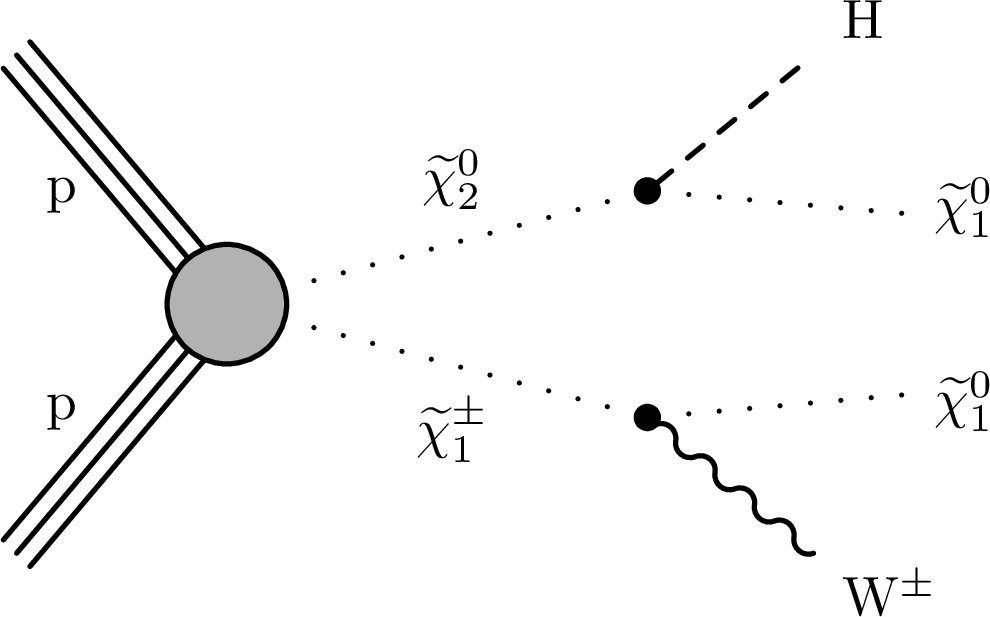
png pdf |
Figure 1:
Diagram corresponding to the SUSY simplified model targeted by this analysis, i.e., chargino-neutralino production, with the chargino decaying to a $\mathrm{ W } $ boson and an LSP, while the heavier neutralino decays to a Higgs boson and an LSP. |
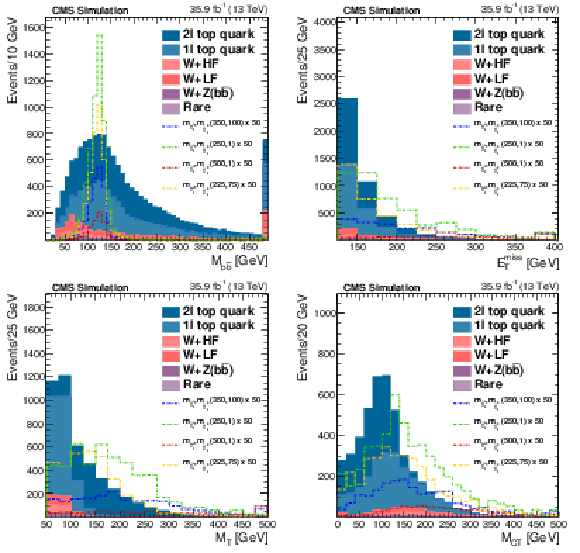
png pdf |
Figure 2:
Distributions in $ {M_{ {\mathrm{ b \bar{b} } } }} $ (top left), $ {E_{\mathrm {T}}^{\text {miss}}} $ (top right), $ {M_{\mathrm {T}}} $ (bottom left), and $ {M_{\mathrm {CT}}} $ (bottom right) for signal and background events in simulation after the preselection. The $ {E_{\mathrm {T}}^{\text {miss}}} $, $ {M_{\mathrm {T}}} $, and $ {M_{\mathrm {CT}}} $ distributions are shown after the 90 $ < {M_{ {\mathrm{ b \bar{b} } } }} < $ 150 GeV requirement. Expected signal distributions are also overlaid as open histograms for various mass points, with the signal cross section scaled up by a factor of 50 for display purposes. The legend entries for signal give the masses $(m_{\tilde{\chi}^{\pm}_1 }, m_{\tilde{\chi}^0_1 })$ in GeV and the factor by which the signal cross section has been scaled. |
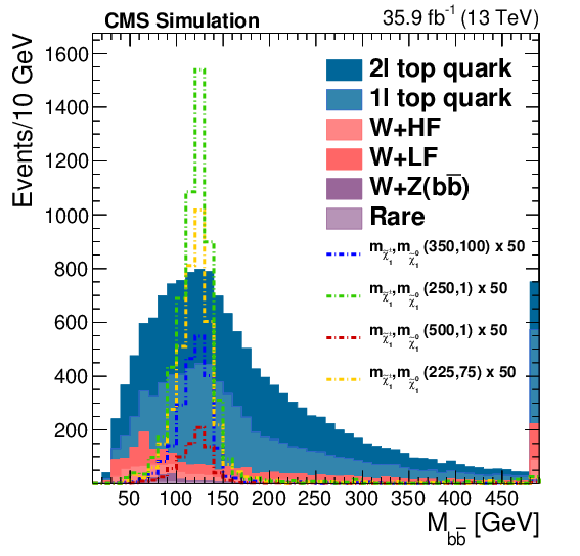
png pdf |
Figure 2-a:
Distribution in $ {M_{ {\mathrm{ b \bar{b} } } }} $ for signal and background events in simulation after the preselection. Expected signal distributions are also overlaid as open histograms for various mass points, with the signal cross section scaled up by a factor of 50 for display purposes. The legend entries for signal give the masses $(m_{\tilde{\chi}^{\pm}_1 }, m_{\tilde{\chi}^0_1 })$ in GeV and the factor by which the signal cross section has been scaled. |
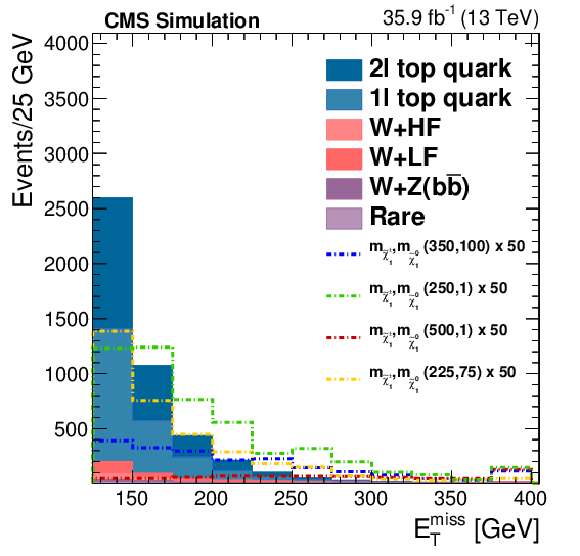
png pdf |
Figure 2-b:
Distribution in $ {E_{\mathrm {T}}^{\text {miss}}} $ for signal and background events in simulation after the preselection. The distribution is shown after the 90 $ < {M_{ {\mathrm{ b \bar{b} } } }} < $ 150 GeV requirement. Expected signal distributions are also overlaid as open histograms for various mass points, with the signal cross section scaled up by a factor of 50 for display purposes. The legend entries for signal give the masses $(m_{\tilde{\chi}^{\pm}_1 }, m_{\tilde{\chi}^0_1 })$ in GeV and the factor by which the signal cross section has been scaled. |
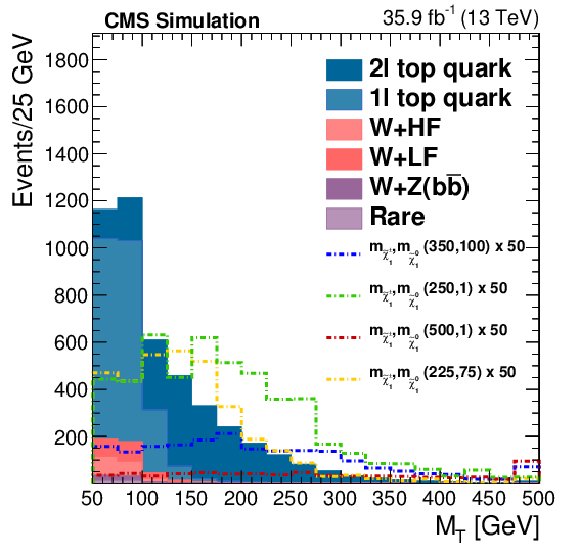
png pdf |
Figure 2-c:
Distribution in $ {M_{\mathrm {T}}} $ for signal and background events in simulation after the preselection. The distribution is shown after the 90 $ < {M_{ {\mathrm{ b \bar{b} } } }} < $ 150 GeV requirement. Expected signal distributions are also overlaid as open histograms for various mass points, with the signal cross section scaled up by a factor of 50 for display purposes. The legend entries for signal give the masses $(m_{\tilde{\chi}^{\pm}_1 }, m_{\tilde{\chi}^0_1 })$ in GeV and the factor by which the signal cross section has been scaled. |
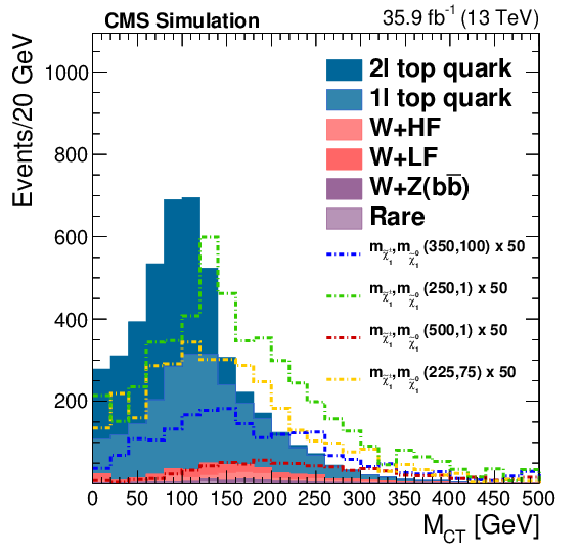
png pdf |
Figure 2-d:
Distribution in $ {M_{\mathrm {CT}}} $ for signal and background events in simulation after the preselection. The distribution is shown after the 90 $ < {M_{ {\mathrm{ b \bar{b} } } }} < $ 150 GeV requirement. Expected signal distributions are also overlaid as open histograms for various mass points, with the signal cross section scaled up by a factor of 50 for display purposes. The legend entries for signal give the masses $(m_{\tilde{\chi}^{\pm}_1 }, m_{\tilde{\chi}^0_1 })$ in GeV and the factor by which the signal cross section has been scaled. |
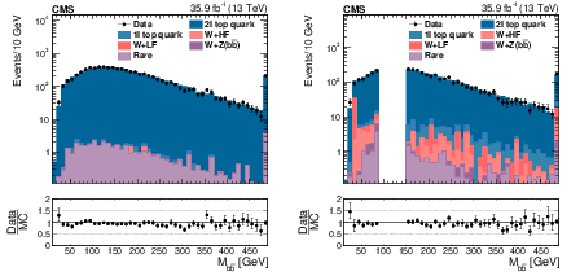
png pdf |
Figure 3:
(left) Distribution in $ {M_{ {\mathrm{ b \bar{b} } } }} $ in $ {\mathrm {CR}2\ell } $ after the selections in Table 1, comparing data to MC simulation. (right) Distribution in $ {M_{ {\mathrm{ b \bar{b} } } }} $ in $ {\mathrm {CRM} {\mathrm{ b \bar{b} } } } $ after preselection with the $ {M_{\mathrm {T}}} $ requirement tightened to be 150 GeV. The signal region range of 90 $ \leq {M_{ {\mathrm{ b \bar{b} } } }} \leq $ 150 GeV has been removed from the plot. |
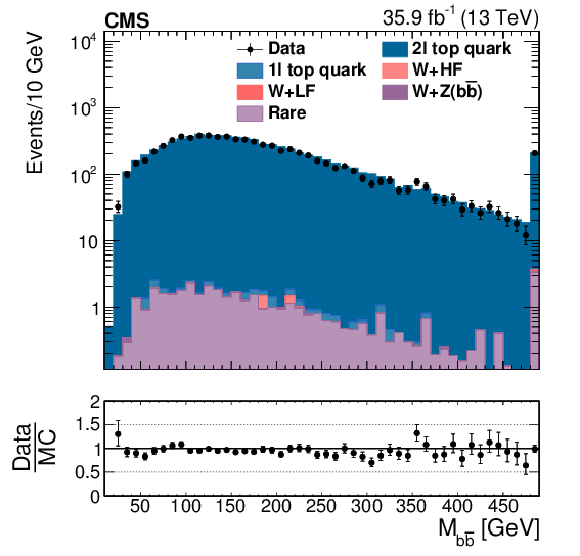
png pdf |
Figure 3-a:
Distribution in $ {M_{ {\mathrm{ b \bar{b} } } }} $ in $ {\mathrm {CR}2\ell } $ after the selections in Table 1, comparing data to MC simulation. |
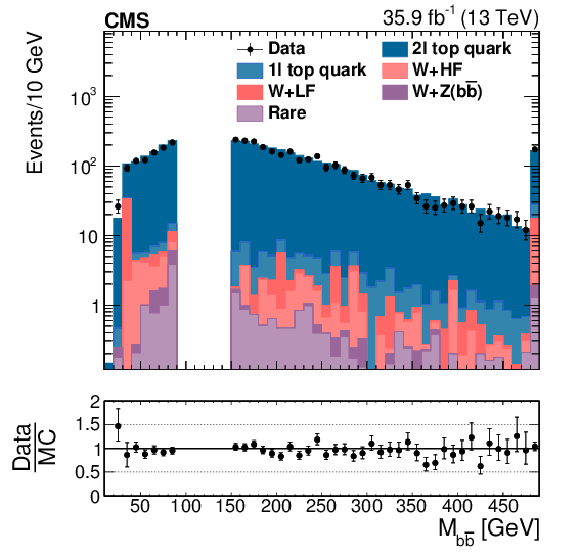
png pdf |
Figure 3-b:
Distribution in $ {M_{ {\mathrm{ b \bar{b} } } }} $ in $ {\mathrm {CRM} {\mathrm{ b \bar{b} } } } $ after preselection with the $ {M_{\mathrm {T}}} $ requirement tightened to be 150 GeV. The signal region range of 90 $ \leq {M_{ {\mathrm{ b \bar{b} } } }} \leq $ 150 GeV has been removed from the plot. |
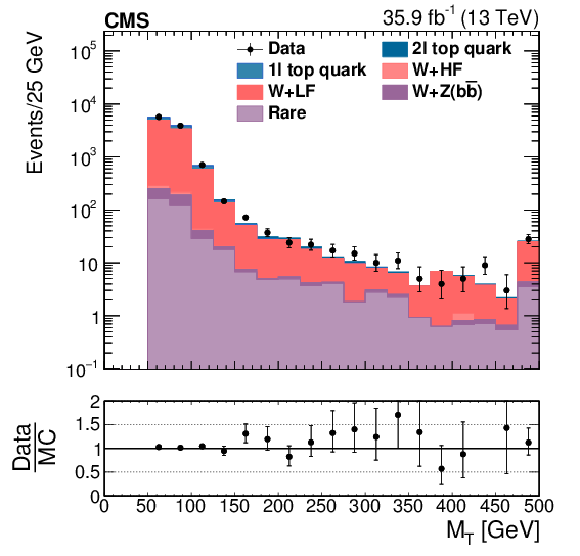
png pdf |
Figure 4:
Distribution in $ {M_{\mathrm {T}}} $ in $ {\mathrm {CR}0\mathrm{ b } } $ after requiring the analysis preselection, the dijet mass window selection, and $ {M_{\mathrm {CT}}} > $ 170 GeV. |
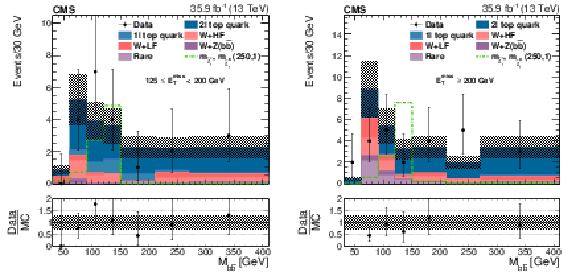
png pdf |
Figure 5:
Distributions in $ {M_{ {\mathrm{ b \bar{b} } } }} $ after all signal region kinematic requirements for the two exclusive $ {E_{\mathrm {T}}^{\text {miss}}} $ bins (left: 125 $ \leq {E_{\mathrm {T}}^{\text {miss}}} < $ 200 GeV, right: $ {E_{\mathrm {T}}^{\text {miss}}} \geq $ 200 GeV). The signal region is 90 $ \leq {M_{ {\mathrm{ b \bar{b} } } }} \leq $ 150 GeV. The hatched band shows the total uncertainty in the background prediction, including statistical and systematic components. The expected signal distribution for a reference SUSY model is overlaid as an open histogram, and the legend (on the last line) gives the masses as $(m_{\tilde{\chi}^{\pm}_1 }, m_{\tilde{\chi}^0_1 })$ in GeV. |

png pdf |
Figure 5-a:
Distributions in $ {M_{ {\mathrm{ b \bar{b} } } }} $ after all signal region kinematic requirements for the two exclusive $ {E_{\mathrm {T}}^{\text {miss}}} $ bins (125 $ \leq {E_{\mathrm {T}}^{\text {miss}}} < $ 200 GeV). The signal region is 90 $ \leq {M_{ {\mathrm{ b \bar{b} } } }} \leq $ 150 GeV. The hatched band shows the total uncertainty in the background prediction, including statistical and systematic components. The expected signal distribution for a reference SUSY model is overlaid as an open histogram, and the legend (on the last line) gives the masses as $(m_{\tilde{\chi}^{\pm}_1 }, m_{\tilde{\chi}^0_1 })$ in GeV. |
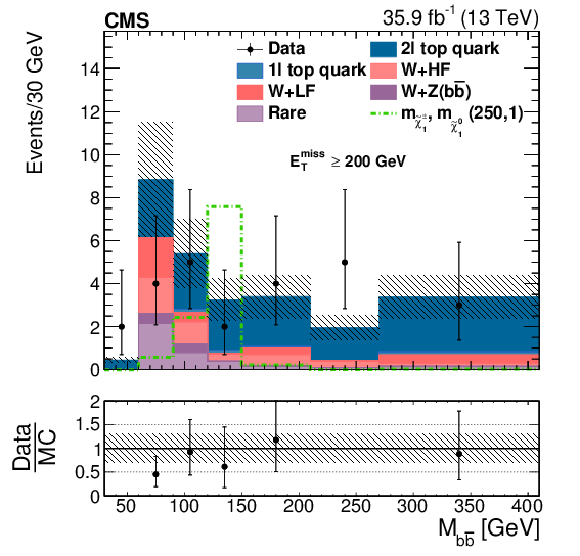
png pdf |
Figure 5-b:
Distributions in $ {M_{ {\mathrm{ b \bar{b} } } }} $ after all signal region kinematic requirements for the two exclusive $ {E_{\mathrm {T}}^{\text {miss}}} $ bins ($ {E_{\mathrm {T}}^{\text {miss}}} \geq $ 200 GeV). The signal region is 90 $ \leq {M_{ {\mathrm{ b \bar{b} } } }} \leq $ 150 GeV. The hatched band shows the total uncertainty in the background prediction, including statistical and systematic components. The expected signal distribution for a reference SUSY model is overlaid as an open histogram, and the legend (on the last line) gives the masses as $(m_{\tilde{\chi}^{\pm}_1 }, m_{\tilde{\chi}^0_1 })$ in GeV. |

png pdf |
Figure 6:
Exclusion limits at the 95% CL in the plane of $m_{\tilde{\chi}^{\pm}_1 }$ and $m_{\tilde{\chi}^0_1 }$. The area below the thick black (dashed red) curve represents the observed (expected) exclusion region. The thin dashed red line indicates the +1 s.d.$_{\text {exp.}}$ experimental uncertainty. The -1 s.d.$_{\text {exp.}}$ line does not appear as no mass points would be excluded in that case. The thin black lines show the effect of the theoretical uncertainties ($\pm $1 s.d.$_{\text {theory}}$) on the signal cross section. |

png pdf root |
Figure 6-a:
Cross section exclusion limits at the 95% CL are shown for $\tilde{\chi}^{\pm}_1 \tilde{\chi}^0_2 \to \mathrm{ W } ^{\pm }\mathrm{ H } \tilde{\chi}^0_1 \tilde{\chi}^0_1 $ as a function of $m_{\tilde{\chi}^{\pm}_1 }$, assuming $m_{\tilde{\chi}^0_1 } = 1$ GeV. The solid black line and points represent the observed exclusion. The dashed black line represents the expected exclusion, while the green and yellow bands indicate the $\pm $1 and 2 standard deviation (s.d.) uncertainties in the expected limit. The magenta line shows the theoretical cross section with its uncertainty. |
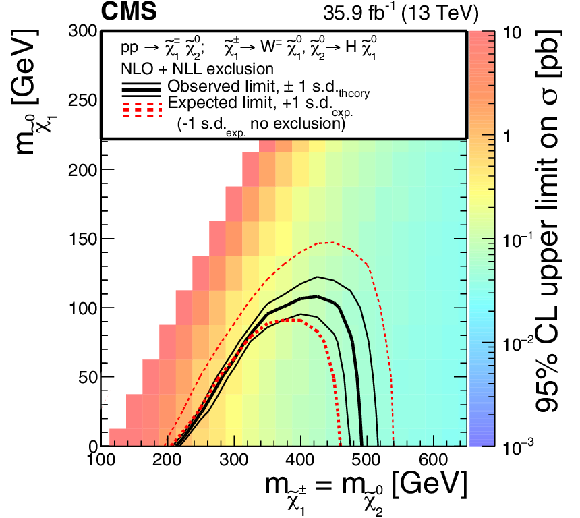
png pdf root |
Figure 6-b:
Exclusion limits at the 95% CL in the plane of $m_{\tilde{\chi}^{\pm}_1 }$ and $m_{\tilde{\chi}^0_1 }$. The area below the thick black (dashed red) curve represents the observed (expected) exclusion region. The thin dashed red line indicates the +1 s.d.$_{\text {exp.}}$ experimental uncertainty. The -1 s.d.$_{\text {exp.}}$ line does not appear as no mass points would be excluded in that case. The thin black lines show the effect of the theoretical uncertainties ($\pm $1 s.d.$_{\text {theory}}$) on the signal cross section. |
| Tables | |
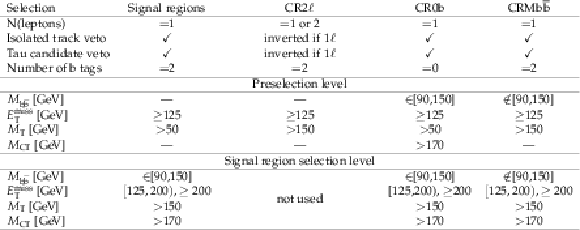
png pdf |
Table 1:
Event selections in signal and control regions. |

png pdf |
Table 2:
Expected and observed event yields in the signal regions. The uncertainties shown include both statistical and systematic sources. The correlation coefficient for the background prediction between the two bins is 0.61. Predicted yields are shown also for several signal models with the masses $(m_{\tilde{\chi}^{\pm}_1 }, m_{\tilde{\chi}^0_1 })$ indicated in GeV and with statistical-only uncertainties. |
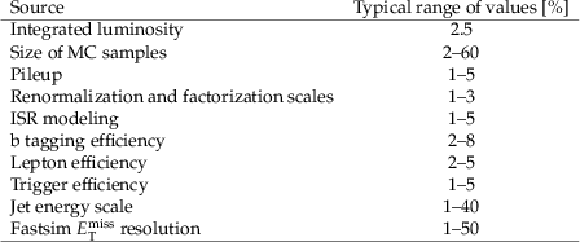
png pdf |
Table 3:
Sources of systematic uncertainty in the estimated signal yield, along with their typical values. The ranges represent variation across the signal masses probed. |
| Summary |
| A search is performed for beyond the standard model physics in events with a leptonically decaying W boson, a Higgs boson decaying to a $\mathrm{ b \bar{b} }$ pair, and large transverse momentum imbalance. The search uses proton-proton collision data recorded by the CMS experiment in 2016 at $\sqrt{s} = $ 13 TeV, corresponding to an integrated luminosity of 35.9 fb$^{-1}$. The event yields observed in data are consistent with the estimated standard model backgrounds. The results are used to set cross section limits on chargino-neutralino production in a simplified supersymmetric model with degenerate masses for $\tilde{\chi}^{\pm}_1 $ and $\tilde{\chi}^0_2 $ and with the decays $\tilde{\chi}^{\pm}_1 \to\mathrm{ W }^{\pm}\tilde{\chi}^0_1 $ and $\tilde{\chi}^0_2 \to\mathrm{ H }\tilde{\chi}^0_1 $. Values of $m_{\tilde{\chi}^{\pm}_1 }$ between 220 and 490 GeV are excluded at 95% confidence level by this search when the $\tilde{\chi}^0_1 $ is massless, and values of $m_{\tilde{\chi}^0_1 }$ are excluded up to 110 GeV for $m_{\tilde{\chi}^{\pm}_1 } \approx $ 450 GeV. These results significantly extend the previous best limits, by up to 270 GeV in $m_{\tilde{\chi}^{\pm}_1 }$ and up to 90 GeV in $m_{\tilde{\chi}^0_1 }$. |
| Additional Tables | |

png pdf |
Additional Table 1:
Cutflow of yields with 35.9 fb$^{-1}$ data for various signal model points, given as $(m_{\tilde{\chi }_{1}^{\pm }},m_{ {\tilde{\chi }_{1}^{0}}})$. The yields are normalized to the theoretical cross sections. The "All events'' category below starts from all generated events where the W boson decays leptonically and the Higgs boson decays to ${\mathrm{ b \bar{b} } } $, taking into account a branching ratio of 0.175. |
| References | ||||
| 1 | P. Ramond | Dual theory for free fermions | PRD 3 (1971) 2415 | |
| 2 | Y. A. Gol'fand and E. P. Likhtman | Extension of the algebra of Poincar$ \'e $ group generators and violation of P invariance | JEPTL 13 (1971)323 | |
| 3 | A. Neveu and J. H. Schwarz | Factorizable dual model of pions | NPB 31 (1971) 86 | |
| 4 | D. V. Volkov and V. P. Akulov | Possible universal neutrino interaction | JEPTL 16 (1972)438 | |
| 5 | J. Wess and B. Zumino | A Lagrangian model invariant under supergauge transformations | PLB 49 (1974) 52 | |
| 6 | J. Wess and B. Zumino | Supergauge transformations in four dimensions | NPB 70 (1974) 39 | |
| 7 | P. Fayet | Supergauge invariant extension of the Higgs mechanism and a model for the electron and its neutrino | NPB 90 (1975) 104 | |
| 8 | H. P. Nilles | Supersymmetry, supergravity and particle physics | Phys. Rep. 110 (1984) 1 | |
| 9 | G. R. Farrar and P. Fayet | Phenomenology of the production, decay, and detection of new hadronic states associated with supersymmetry | PLB 76 (1978) 575 | |
| 10 | C. Boehm, A. Djouadi, and M. Drees | Light scalar top quarks and supersymmetric dark matter | PRD 62 (2000) 035012 | hep-ph/9911496 |
| 11 | C. Bal\'azs, M. Carena, and C. E. M. Wagnerr | Dark matter, light top squarks, and electroweak baryogenesis | PRD 70 (2004) 015007 | hep-ph/403224 |
| 12 | ATLAS Collaboration | Search for new phenomena in final states with large jet multiplicities and missing transverse momentum with ATLAS using $ \sqrt{s} = $ 13 TeV proton-proton collisions | PLB 757 (2016) 334 | 1602.06194 |
| 13 | ATLAS Collaboration | Search for new phenomena in final states with an energetic jet and large missing transverse momentum in pp collisions at $ \sqrt{s}= $ 13 TeV using the ATLAS detector | PRD 94 (2016) 032005 | 1604.07773 |
| 14 | ATLAS Collaboration | Search for squarks and gluinos in final states with jets and missing transverse momentum at $ \sqrt{s} = $ 13 TeV with the ATLAS detector | EPJC 76 (2016) 392 | 1605.03814 |
| 15 | ATLAS Collaboration | Search for pair production of gluinos decaying via stop and sbottom in events with b jets and large missing transverse momentum in pp collisions at $ \sqrt{s} = $ 13 TeV with the ATLAS detector | PRD 94 (2016) 032003 | 1605.09318 |
| 16 | CMS Collaboration | Search for new physics with the M$ _{T2} $ variable in all-jets final states produced in pp collisions at $ \sqrt{s}= $ 13 TeV | JHEP 10 (2016) 006 | CMS-SUS-15-003 1603.04053 |
| 17 | CMS Collaboration | Search for supersymmetry in multijet events with missing transverse momentum in proton-proton collisions at 13 TeV | Submitted to \it PRD | CMS-SUS-16-033 1704.07781 |
| 18 | CMS Collaboration | Inclusive search for supersymmetry using razor variables in pp collisions at $ \sqrt{s} = $ 13 TeV | PRD 95 (2017) 012003 | CMS-SUS-15-004 1609.07658 |
| 19 | CMS Collaboration | A search for new phenomena in pp collisions at $ \sqrt{s} = $ 13 TeV in final states with missing transverse momentum and at least one jet using the $ \alpha _{\mathrm {T}} $ variable | EPJC 77 (2017) 294 | CMS-SUS-15-005 1611.00338 |
| 20 | ATLAS Collaboration | Search for supersymmetry at $ \sqrt{s}= $ 13 TeV in final states with jets and two same-sign leptons or three leptons with the ATLAS detector | EPJC 76 (2016) 259 | 1602.09058 |
| 21 | CMS Collaboration | Search for physics beyond the standard model in events with two leptons of same sign, missing transverse momentum, and jets in proton-proton collisions at $ \sqrt{s} = $ 13 ~TeV | Submitted to \it EPJC | CMS-SUS-16-035 1704.07323 |
| 22 | ATLAS Collaboration | Search for top squarks in final states with one isolated lepton, jets, and missing transverse momentum in $ \sqrt{s}= $ 13 TeV pp collisions with the ATLAS detector | PRD 94 (2016) 052009 | 1606.03903 |
| 23 | ATLAS Collaboration | Search for new phenomena in final states with large jet multiplicities and missing transverse momentum with ATLAS using $ \sqrt{s} = $ 13 TeV proton-proton collisions | PLB 757 (2016) 334 | 1602.06194 |
| 24 | ATLAS Collaboration | Search for gluinos in events with an isolated lepton, jets and missing transverse momentum at $ \sqrt{s} = $ 13 Te V with the ATLAS detector | EPJC 76 (2016) 565 | 1605.04285 |
| 25 | CMS Collaboration | Search for supersymmetry in the all-hadronic final state using top quark tagging in pp collisions at $ \sqrt{s} = $ 13 TeV | Submitted to \it PRD | CMS-SUS-16-009 1701.01954 |
| 26 | CMS Collaboration | Search for supersymmetry in events with one lepton and multiple jets in proton-proton collisions at $ \sqrt{s} = $ 13 TeV | PRD 95 (2017) 012011 | CMS-SUS-15-006 1609.09386 |
| 27 | CMS Collaboration | Search for supersymmetry with multiple charged leptons in proton-proton collisions at $ \sqrt{s} = $ 13 TeV | Submitted to \it Eur. J. Phys. C | CMS-SUS-16-003 1701.06940 |
| 28 | CMS Collaboration | Search for supersymmetry in pp collisions at $ \sqrt{s}= $ 13 TeV in the single-lepton final state using the sum of masses of large-radius jets | JHEP 08 (2016) 122 | CMS-SUS-15-007 1605.04608 |
| 29 | ATLAS, CMS Collaboration | Measurements of the Higgs boson production and decay rates and constraints on its couplings from a combined ATLAS and CMS analysis of the LHC pp collision data at $ \sqrt{s}= $ 7 and 8 TeV | JHEP 08 (2016) 045 | 1606.02266 |
| 30 | S. P. Martin | A supersymmetry primer | in Perspectives on Supersymmetry II, G. L. Kane, ed., p. 1 World Scientific, 2010 Adv. Ser. Direct. High Energy Phys., vol. 21 | hep-ph/9709356 |
| 31 | N. Arkani-Hamed et al. | MARMOSET: The Path from LHC Data to the New Standard Model via On-Shell Effective Theories | hep-ph/0703088 | |
| 32 | J. Alwall, P. Schuster, and N. Toro | Simplified models for a first characterization of new physics at the LHC | PRD 79 (2009) 075020 | 0810.3921 |
| 33 | J. Alwall, M.-P. Le, M. Lisanti, and J. G. Wacker | Model-independent jets plus missing energy searches | PRD 79 (2009) 015005 | 0809.3264 |
| 34 | D. Alves et al. | Simplified models for LHC new physics searches | JPG 39 (2012) 105005 | 1105.2838 |
| 35 | CMS Collaboration | Interpretation of searches for supersymmetry with simplified models | PRD 88 (2013) 052017 | CMS-SUS-11-016 1301.2175 |
| 36 | CMS Collaboration | Searches for electroweak neutralino and chargino production in channels with Higgs, Z, and W bosons in pp collisions at 8 TeV | PRD 90 (2014) 092007 | CMS-SUS-14-002 1409.3168 |
| 37 | CMS Collaboration | Searches for electroweak production of charginos, neutralinos, and sleptons decaying to leptons and W, Z, and Higgs bosons in pp collisions at 8 TeV | EPJC 74 (2014) 3036 | CMS-SUS-13-006 1405.7570 |
| 38 | ATLAS Collaboration | Search for the electroweak production of supersymmetric particles in $ \sqrt{s} = $ 8 ~TeV pp collisions with the ATLAS detector | PRD 93 (2016) 052002 | 1509.07152 |
| 39 | CMS Collaboration | The CMS experiment at the CERN LHC | JINST 3 (2008) S08004 | CMS-00-001 |
| 40 | CMS Collaboration | Particle-flow event reconstruction in CMS and performance for jets, taus, and $ E_{\mathrm{T}}^{\text{miss}} $ | CMS-PAS-PFT-09-001 | |
| 41 | CMS Collaboration | Commissioning of the particle-flow event with the first LHC collisions recorded in the CMS detector | CMS-PAS-PFT-10-001 | |
| 42 | M. Cacciari, G. P. Salam, and G. Soyez | The anti-$ k_t $ jet clustering algorithm | JHEP 04 (2008) 063 | 0802.1189 |
| 43 | M. Cacciari, G. P. Salam, and G. Soyez | FastJet user manual | EPJC 72 (2012) 1896 | 1111.6097 |
| 44 | CMS Collaboration | Missing transverse energy performance of the CMS detector | JINST 6 (2011) P09001 | CMS-JME-10-009 1106.5048 |
| 45 | CMS Collaboration | Performance of electron reconstruction and selection with the CMS detector in proton-proton collisions at $ \sqrt{s} = $ 8 ~TeV | JINST 10 (2015) P06005 | CMS-EGM-13-001 1502.02701 |
| 46 | CMS Collaboration | Performance of CMS muon reconstruction in pp collision events at $ \sqrt{s}= $ 7 TeV | JINST 7 (2012) P10002 | CMS-MUO-10-004 1206.4071 |
| 47 | CMS Collaboration | Description and performance of track and primary-vertex reconstruction with the CMS tracker | JINST 9 (2014) P10009 | CMS-TRK-11-001 1405.6569 |
| 48 | M. Cacciari and G. P. Salam | Pileup subtraction using jet areas | PLB 659 (2008) 119 | 0707.1378 |
| 49 | CMS Collaboration | Determination of jet energy calibration and transverse momentum resolution in CMS | JINST 6 (2011) P11002 | CMS-JME-10-011 1107.4277 |
| 50 | CMS Collaboration | Jet energy scale and resolution in the CMS experiment in pp collisions at 8 TeV | JINST 12 (2017) P02014 | CMS-JME-13-004 1607.03663 |
| 51 | CMS Collaboration | Identification of b-quark jets with the CMS experiment | JINST 8 (2013) P04013 | CMS-BTV-12-001 1211.4462 |
| 52 | CMS Collaboration | Reconstruction and identification of $ \tau $ lepton decays to hadrons and $ \nu_{\tau} $ at CMS | JINST 11 (2016) P01019 | CMS-TAU-14-001 1510.07488 |
| 53 | D. R. Tovey | On measuring the masses of pair-produced semi-invisibly decaying particles at hadron colliders | JHEP 04 (2008) 034 | 0802.2879 |
| 54 | G. Polesello and D. R. Tovey | Supersymmetric particle mass measurement with the boost-corrected contransverse mass | JHEP 03 (2010) 030 | 0910.0174 |
| 55 | J. Alwall et al. | The automated computation of tree-level and next-to-leading order differential cross sections, and their matching to parton shower simulations | JHEP 07 (2014) 079 | 1405.0301 |
| 56 | J. Alwall et al. | Comparative study of various algorithms for the merging of parton showers and matrix elements in hadronic collisions | EPJC 53 (2008) 473 | 0706.2569 |
| 57 | P. Nason | A new method for combining NLO QCD with shower Monte Carlo algorithms | JHEP 11 (2004) 040 | hep-ph/0409146 |
| 58 | S. Frixione, P. Nason, and C. Oleari | Matching NLO QCD computations with parton shower simulations: the $ POWHEG $ method | JHEP 11 (2007) 070 | 0709.2092 |
| 59 | S. Alioli, P. Nason, C. Oleari, and E. Re | A general framework for implementing NLO calculations in shower Monte Carlo programs: the $ POWHEG $ BOX | JHEP 06 (2010) 043 | 1002.2581 |
| 60 | NNPDF Collaboration | Parton distributions for the LHC Run II | JHEP 04 (2015) 040 | 1410.8849 |
| 61 | R. Frederix and S. Frixione | Merging meets matching in MC@NLO | JHEP 12 (2012) 061 | 1209.6215 |
| 62 | S. Alioli, P. Nason, C. Oleari, and E. Re | NLO single-top production matched with shower in POWHEG: $ s $- and $ t $-channel contributions | JHEP 09 (2009) 111 | 0907.4076 |
| 63 | E. Re | Single-top Wt-channel production matched with parton showers using the POWHEG method | EPJC 71 (2011) 1547 | 1009.2450 |
| 64 | T. Melia, P. Nason, R. Rontsch, and G. Zanderighi | W$ ^+ $W$ ^- $, WZ and ZZ production in the POWHEG BOX | JHEP 11 (2011) 078 | 1107.5051 |
| 65 | M. Beneke, P. Falgari, S. Klein, and C. Schwinn | Hadronic top-quark pair production with NNLL threshold resummation | NPB 855 (2012) 695 | 1109.1536 |
| 66 | M. Cacciari et al. | Top-pair production at hadron colliders with next-to-next-to-leading logarithmic soft-gluon resummation | PLB 710 (2012) 612 | 1111.5869 |
| 67 | P. Barnreuther, M. Czakon, and A. Mitov | Percent-level-precision physics at the Tevatron: Next-to-next-to-leading order QCD corrections to $ \mathrm{q\bar{q}}\to \mathrm{t\bar{t}} + X $ | PRL 109 (2012) 132001 | 1204.5201 |
| 68 | M. Czakon and A. Mitov | NNLO corrections to top-pair production at hadron colliders: the all-fermionic scattering channels | JHEP 12 (2012) 054 | 1207.0236 |
| 69 | M. Czakon and A. Mitov | NNLO corrections to top pair production at hadron colliders: the quark-gluon reaction | JHEP 01 (2013) 080 | 1210.6832 |
| 70 | M. Czakon, P. Fiedler, and A. Mitov | Total top-quark pair-production cross section at hadron colliders through $ O(\alpha_S^4) $ | PRL 110 (2013) 252004 | 1303.6254 |
| 71 | R. Gavin, Y. Li, F. Petriello, and S. Quackenbush | W Physics at the LHC with FEWZ 2.1 | CPC 184 (2013) 208 | 1201.5896 |
| 72 | R. Gavin, Y. Li, F. Petriello, and S. Quackenbush | FEWZ 2.0: A code for hadronic Z production at next-to-next-to-leading order | CPC 182 (2011) 2388 | 1011.3540 |
| 73 | CMS Collaboration | Search for top-squark pair production in the single-lepton final state in pp collisions at $ \sqrt{s} = $ 8 TeV | EPJC 73 (2013) 2677 | CMS-SUS-13-011 1308.1586 |
| 74 | T. Sjostrand, S. Mrenna, and P. Z. Skands | A brief introduction to PYTHIA 8.1 | CPC 178 (2008) 852 | 0710.3820 |
| 75 | CMS Collaboration | Event generator tunes obtained from underlying event and multiparton scattering measurements | EPJC 76 (2016) 155 | CMS-GEN-14-001 1512.00815 |
| 76 | \GEANTfour Collaboration | $ GEANT4 -- a $ simulation toolkit | NIMA 506 (2003) 250 | |
| 77 | S. Abdullin et al. | The fast simulation of the CMS detector at LHC | J. Phys. Conf. Ser. 331 (2011) 032049 | |
| 78 | CMS Collaboration | Searches for pair production of third-generation squarks in $ \sqrt{s}= $ 13 TeV pp collisions | EPJC 77 (2017) 327 | CMS-SUS-16-008 1612.03877 |
| 79 | CMS Collaboration | Measurement of the WZ production cross section in pp collisions at $ \sqrt{s} = $ 13 TeV | PLB 766 (2017) 268 | CMS-SMP-16-002 1607.06943 |
| 80 | CMS Collaboration | Simplified likelihood for the re-interpretation of public CMS results | CDS | |
| 81 | A. L. Read | Presentation of search results: the $ CL_s $ technique | JPG 28 (2002) 2693 | |
| 82 | T. Junk | Confidence level computation for combining searches with small statistics | NIMA 434 (1999) 435 | hep-ex/9902006 |
| 83 | G. Cowan, K. Cranmer, E. Gross, and O. Vitells | Asymptotic formulae for likelihood-based tests of new physics | EPJC 71 (2011) 1554 | 1007.1727 |
| 84 | ATLAS and CMS Collaborations | Procedure for the LHC Higgs boson search combination in summer 2011 | CMS-NOTE-2011-005 | |
| 85 | B. Fuks, M. Klasen, D. R. Lamprea, and M. Rothering | Gaugino production in proton-proton collisions at a center-of-mass energy of 8 TeV | JHEP 10 (2012) 081 | 1207.2159 |
| 86 | B. Fuks, M. Klasen, D. R. Lamprea, and M. Rothering | Precision predictions for electroweak superpartner production at hadron colliders with Resummino | EPJC 73 (2013) 2480 | 1304.0790 |
| 87 | CMS Collaboration | CMS luminosity measurements for the 2016 data taking period | CMS-PAS-LUM-17-001 | CMS-PAS-LUM-17-001 |

|
Compact Muon Solenoid LHC, CERN |

|

|

|

|

|

|